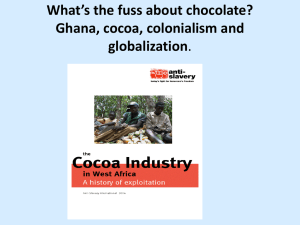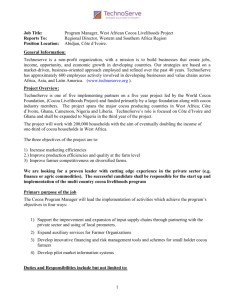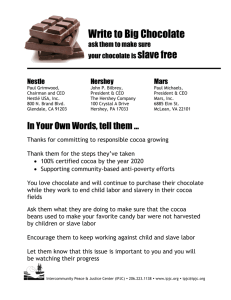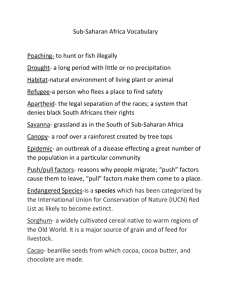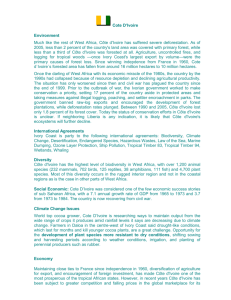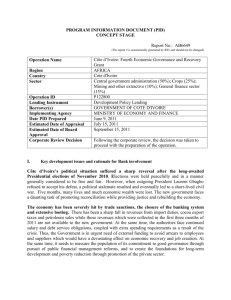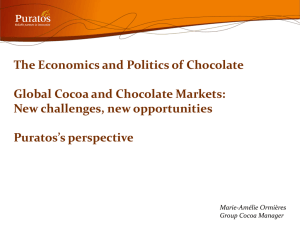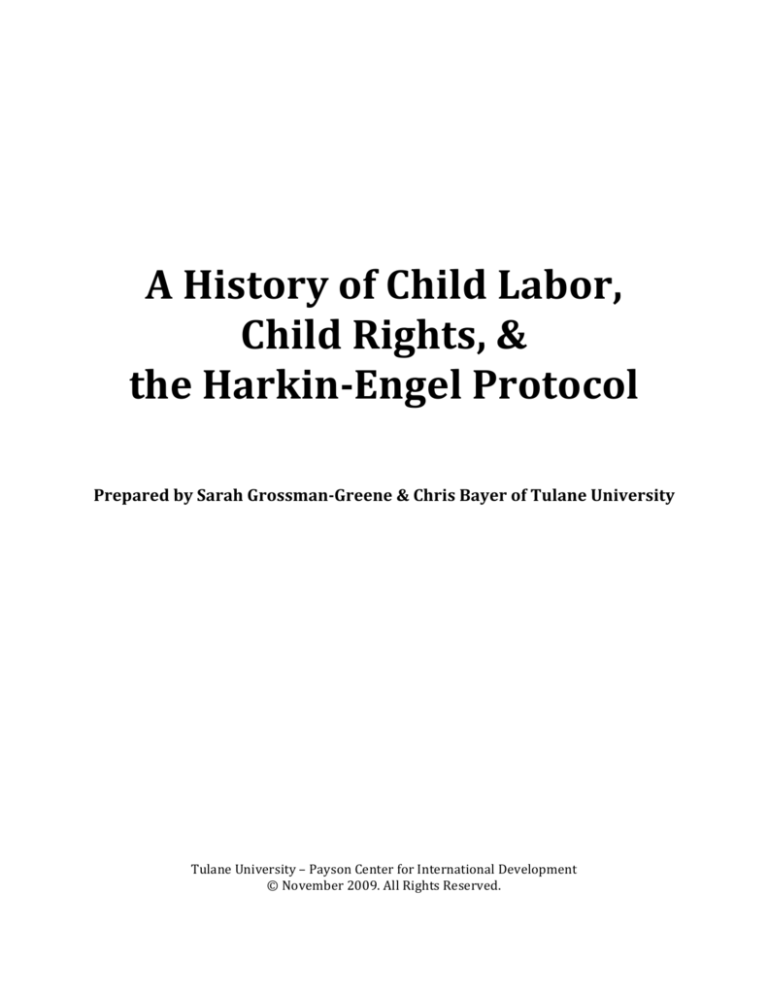
A History of Child Labor, Child Rights, & the Harkin-­Engel Protocol Prepared by Sarah Grossman-­Greene & Chris Bayer of Tulane University Tulane University – Payson Center for International Development © November 2009. All Rights Reserved. TABLE OF CONTENTS INTRODUCTION.................................................................................................................................................... 3 CHILD LABOR IN THE UNITED STATES......................................................................................................... 4 THE EVOLUTION OF CHILD LABOR AS A HUMAN RIGHTS ISSUE ......................................................... 5 RECENT U.S. LEGISLATION – ENABLING THE MECHANISMS FOR SANCTIONS AND BLACKLISTING...................................................................................................................................................... 7 INTERNATIONAL CHILD LABOR ISSUES ....................................................................................................... 9 PAKISTAN .................................................................................................................................................................................... 9 THAILAND ................................................................................................................................................................................ 10 BRAZIL ...................................................................................................................................................................................... 10 CÔTE D’IVOIRE AND GHANA ................................................................................................................................................. 11 THE HARKIN-­ENGEL PROTOCOL ..................................................................................................................11 DEVELOPMENTS SINCE THE PROTOCOL....................................................................................................12 CONCLUSION........................................................................................................................................................13 2 Introduction This paper traces the main historical events concerning child labor in the United States and outlines in broad strokes the politicization of the issue and consequent legislation. America’s own experience with respect to child labor serves as the context to explain subsequent U.S. engagement in international child labor disputes and attempts at resolving these issues. Multilateral organizations have progressively refined the definition of child labor and passed legislation that seeks to control its prevalence. These internationally agreed upon standards, along with U.S. economic policy, are used by the U.S. government to mobilize stakeholders against the incidence and severity of child labor abroad. The Harkin-­‐Engel Protocol (the Protocol), signed in 2001, was a response to an emerging international and sector-­‐wide labor issue – that cocoa grown in Côte d’Ivoire and Ghana had been produced with the worst forms of child labor. The Protocol is significant in that its signatories acknowledge the importance of the issue and it is unique in that it was one of the first voluntary agreements for regulating an industry in U.S. history. It is furthermore historical in demonstrating that there are increasing consequences for non-­‐compliance with international standards. The diagram below depicts the conceptual framework of the paper. Its elements also inform the main topics of this paper. All elements, save U.S. domestic legislation, directly relate to number 5, international child labor disputes and resolutions – the third and fourth elements constituting the principal mechanisms for enforcing standards. 3 Child Labor in the United States As late as the mid-­‐20th century, severe forms of child labor existed in the United States.1 Although children had long been members of the American labor force, the rapid technological innovations of the 19th century drastically changed the nature of their work. By the century’s close, many young workers had moved from small scale family-­‐based production – where children trained with their parents or acted as apprentices to master craftsmen within their own communities – to industrial, factory-­‐based production, where they were subjected to hazardous conditions that today would be labeled among of the worst forms of child labor. In a comparatively short amount of time, a strong opposition to industry-­‐based child exploitation emerged in the U.S. spurred on by the Progressive Movement and the publicity generated by journalists. According to Anne Effland, Progressive reformers viewed childhood: as a distinct stage of life requiring a tailored set of experiences and education to prepare for adulthood […] Children needed protection from the harsh realities of the increasingly industrialized world if they were to grow and mature properly. Reformers, thus, viewed industrial work as both dangerous to a child’s health and detrimental to a child’s mental development.2 The “breaker boys” epitomized the type of child labor Progressive Movement reformers condemned. These boys, as young as 10 or 11, worked in mines where they separated coal from slate and faced extreme conditions that resulted in chronic throat trouble, respiratory illness, hearing loss, loss of digits, etc.3 In a series of investigative photo essays, Lewis Hine helped to expose the harsh reality of children’s work in mining and other industrial and commercial enterprises, and in doing so provided widespread publicity and sympathy for the Progressive movement.4 Progressive reformers, while strongly opposed to child labor in mining, manufacturing, and urban street trades, had divergent views for agricultural work. Many subscribed to the agrarian ideals of the “wholesomeness” of farm work and rural life, popularly attributed to Thomas Jefferson. Farm work gave children the benefits of fresh air, outdoor recreation, and contact with nature.5 However, by the early 20th century, commercial agriculture had little to do with the idealized view of the family farm and its demands were becoming increasingly similar to those of factory work. According to an investigator of a sugar beet farm in Colorado: Children under the contract system are in a situation very different from that of the child in the older type of agriculture working on a farm owned by his family… the only 1 According to United States census data, in 1920 there were 2,773,506 child workers (between the ages of 10 and 17). 1,125,220 children worked in agriculture, 772,850 worked in manufacturing and mechanical industries, and 320,421 worked in clerical occupations. U.S. Census Bureau, 1920 U.S. Census: Children in Gainful Occupations (1920), 476. Available from http://www2.census.gov/prod2/decennial/documents/41084484v4ch05.pdf; Internet; accessed 6 Oct 2009. 2 Anne B.W. Effland, “Agrarianism and Child Labor Policy for Agriculture,” Agricultural History, Vol. 79, No. 3 (Summer 2005): 284. 3 Michael A. Tonya, “Baby Steps Toward International Fair Labor Standards: Evaluating the Child Labor Deterrence Act,” Case Western Reserve Journal of International Law, Vol. 24 No. 3 (Summer 1992): 632. 4 The History Place, Child Labor in America 1908-­1912 Photographs of Lewis W. Hine, available from http://www.historyplace.com/unitedstates/childlabor/about.htm; Internet; accessed 6 Oct 2009. 5Anne B.W. Effland, “Agrarianism and Child Labor Policy for Agriculture,” Agricultural History, Vol. 79, No. 3 (Summer 2005): 285. 4 consideration governing the work of the child is his use as a factor in a system of production for profit… This is parallel to the situation in industry which resulted in long hours and work at high speed under pressure for children… a further analogy between industry and the cultivation of sugar beets is found in the nature of the work… characterized by a degree of standardization, strain, and repetition of minute processes in monotonous succession.6 Progressive reformers had long championed education as a fundamental right of the child and couched their arguments for child labor regulation in these terms. Although states did pass compulsory school attendance laws, the first in Massachusetts in 1852, there were a number of exemptions written into these laws to accommodate the specific nature of farm work and officials were not categorically consequential in their enforcement.7 In addition to the compulsory education laws, by 1900 most states regulated child labor to some extent. According to Effland, “most commonly, these laws prohibited children from employment in circus-­‐type activities and street entertainment. Children were also generally prohibited from working in mining and in dangerous factory occupations, such as cleaning moving machinery.”8 The Supreme Court struck down the 1916 Keating-­‐Owens Child Labor Act, which attempted to limit child labor by prohibiting the interstate commerce of goods produced with child labor. A second attempt in 1918, which levied a tax on goods produced with child labor and traded through interstate commerce, lasted only until 1922 when it succumbed to a court challenge. Reformers finally succeeded in 1938 with the passage of the Fair Labor Standards Act, which reestablished national minimum age standards and limitations on hours of work for children in most industries. It furthermore proscribed employment in hazardous occupations for children under 18 and even restricted parents’ employment of their own children.9 Despite changes in child labor legislation, some sources10 argue that these new laws had little to do with the decline in child labor, which instead they attribute to a number of external, economic factors – notably technological innovations and changes in the labor market. Advances that provided the backbone for mass production, such as the internal combustion engine, electrical power, the draper loom, and continuous processing techniques, considerably reduced the demand for unskilled labor required in industrial and agricultural work. Simultaneously, the massive unemployment of the Great Depression coupled with the rising flood of immigrants increased the supply of unskilled labor and therefore progressively reduced the demand for child labor.11 The Evolution of Child Labor as a Human Rights Issue The first international recognition of child labor as a human rights issue was put forth in 1924 with the Declaration of Geneva on the Rights of the Child, adopted by the Council of the League of 6 Ibid. p. 289. 7 Ibid. p. 290. 8 Ibid. p. 283. 9 Ibid. 10 U.S. Census Bureau, 1930 U.S. Census: Children in Gainful Occupations (1930), 344. Available from http://www2.census.gov/prod2/decennial/documents/41129379v5ch6.pdf; Internet; accessed 6 Oct 2009. 11 Ibid. 5 Nations Assembly.12 Paragraph IV of the Declaration states that “the child must be put in a position to earn a livelihood and must be protected against every form of exploitation.” This precedent was followed by the 1966 International Covenant on Economic, Social and Cultural Rights (ICESCR) and Convention No. 138 (C138) concerning Minimum Age for Admission to Employment adopted by the International Labor Organization (ILO) in 1973. Article 10(3) of ICESCR declares that: Children and young persons should be protected from economic and social exploitation. Their employment in work harmful to their morals or health or dangerous to life or likely to hamper their normal development should be punishable by law. States should also set age limits below which the paid employment of child labor should be prohibited and punishable by law.13 Article 1 of C138 stipulates that: Each Member for which this Convention is in force undertakes to pursue a national policy designed to ensure the effective abolition of child labour and to raise progressively the minimum age for admission to employment or to work at a level consistent with the fullest physical and mental development of young persons.14 The 1989 United Nations Convention on the Rights of the Child (CRC)15 was a milestone in that it explicitly classified the problem of child labor as a human rights issue. Article 32(1) states that: States Parties recognize the right of the child to be protected from economic exploitation and from performing any work that is likely to be hazardous or to interfere with the child’s education, or be harmful to the child’s health or physical, mental, spiritual, moral or social development.16 Other rights included in the Convention are Article 19, requiring the member states “to protect the child from all forms of physical or mental violence, injury or abuse, neglect or negligent treatment, maltreatment or exploitation, including sexual abuse,” Article 24 recognizing “the right of the child to the enjoyment of the highest attainable standard of health,” Article 27, recognizing “the right of every child to a standard of living adequate for the child’s physical, mental, spiritual, moral and social development,” and Article 28, recognizing “the right of the child to education,” to name a few. 12 League of Nations, Geneva Declaration of the Rights of the Child (26 September 1924). Available from http://www.un-­‐
documents.net/gdrc1924.htm; Internet; accessed 6 Oct 2009. 13 UN General Assembly, International Covenant on Economic, Social and Cultural Rights (16 December 1966). Available from http://www.unhcr.org/refworld/docid/3ae6b36c0.html; Internet, accessed 6 Oct 2009. 14 ILO, Convention Concerning Minimum Age for Admission to Employment (26 June 1973). Available from http://www.ilo.org/ilolex/cgi-­‐lex/convde.pl?C138; Internet; accessed 6 Oct 2009. 15 Although the U.S. government played an active role in drafting the CRC and is a signatory to the convention, along with Somalia, it is one of two UN member countries that have not ratified it. 16 UN General Assembly, Convention on the Rights of the Child (20 Nov 1989). Available from http://www2.ohchr.org/english/law/crc.htm; Internet; accessed 6 Oct 2009. 6 In 1999, a decade after the CRC, the ILO adopted Convention No. 182 (C182) concerning the Prohibition and Immediate Elimination of the Worst forms of Child Labour.17 Article 1 of which states that “each member which ratifies this Convention shall take immediate and effective measures to secure the prohibition and elimination of the worst forms of child labour as a matter of urgency.” Following its own societal dialectic vis-­‐à-­‐vis child labor, the United States has played a visible role in the creation of international child labor and rights legislation. President Clinton, who was in office during the development of ILO Convention 182, displayed a strong show of support when he delivered a speech to the ILO urging governments worldwide to adopt the treaty. In doing so, Clinton was the first U.S. president to address the ILO.18 Recent U.S. Legislation – Enabling the Mechanisms For Sanctions and Blacklisting In addition to participating in the condemnation of child labor through multilateral organizations, in the last 11 years the U.S. government has taken significant steps on its own to combat child labor and human trafficking abroad. In 1998, President Clinton announced a Presidential Directive on Steps to Combat Violence Against Women and Trafficking in Women and Girls.19 On June 12th of the following year, a few days before his speech to the ILO, he issued Executive Order No. 1312620 concerning the Prohibition of Acquisition of Products Produced by Forced Indentured Child Labor. Order 13126 prohibits federal agencies from buying products that have been made with forced or indentured labor and effectively serves as a blacklist against the products listed therein. Congress passed another provision in 2000, the Trafficking Victims Prevention Act (TVPA),21 which guides U.S. efforts to combat human trafficking. As of 2001, the U.S. State Department, as required by the Act, has issued an annual report on foreign governments’ efforts to eliminate severe forms of trafficking in persons (the TIP report). The report ranks countries within one of three tier lists based on the extent of government action to combat trafficking as outlined in the TVPA. The rankings from TIP are as follows:22 • Tier 1: Countries whose governments fully comply with the TVPA’s minimum standards. 17 ILO, Convention concerning the Prohibition and Immediate Action for the Elimination of the Worst Forms of Child Labour (17 June 1999). Available from http://www.ilo.org/public/english/standards/relm/ilc/ilc87/com-­‐chic.htm; Internet; accessed 6 Oct 2009. 18 Sandra Sobieraj, “Clinton backs treaty on child labor abuses President’s European diplomacy trip begins with speech to the International Labor Organization,” The Atlanta Journal-­Constitution, 16 Jun 1999, sec. A, p. 13. 19 US Dept. of State, Human Smuggling and Trafficking Center (HSTC) Charter and Amendments. Available from http://www.state.gov/m/ds/hstcenter/41444.htm; Internet, accessed 6 Oct 2009. 20 USDOL, Executive Order 13126 (1999). Available from http://www.dol.gov/ILAB/regs/eo13126/main.htm; Internet; accessed 6 Oct 2009. 21 US Public Law, Victims of Trafficking and Violence Protection Act of 2000 (28 Oct 2000). Available from http://www.state.gov/documents/organization/10492.pdf; Internet; accessed 6 Oct 2009. 22 US Dept. of State, Trafficking in Persons Report 2009 (16 June 2009), 49. Available from http://www.state.gov/g/tip/rls/tiprpt/2009/; Internet; accessed 6 Oct 2009. 7 •
Tier 2: Countries whose governments do not full comply with the TVPA’s minimum standards, but are making significant efforts to bring themselves into compliance with those standards. •
Tier 2 Watch List: Tier 2 AND: a. The absolute number of victims of severe forms of trafficking is very significant or is significantly increasing; or b. There is a failure to provide evidence of increasing efforts to combat severe forms of trafficking in persons from the previous year; or c.
•
The determination that a country is making significant efforts to bring itself into compliance with the minimum standards was based on commitments by the country to take additional steps over the next year Tier 3: Countries whose governments do not fully comply with the minimum standards and are not making significant efforts to do so. The most recent amendment to TVPA, the William Wilberforce Trafficking Victims Protection Reauthorization Act of 2008 (TVPRA), stipulates that any country ranked Tier 2 Watch List for two consecutive years (beginning with the 2009 Report) will be ranked Tier 3 the following year.23 Governments of countries on Tier 3 may be subject to certain sanctions from the U.S. Government – which may entail the withholding of nonhumanitarian, non-­‐trade-­‐related foreign assistance – as well as from the International Monetary Fund and the World Bank – which can also choose to deny assistance.24 Section 105(b)(2)(c) of the Act’s 2005 reauthorization states that the Bureau of International Labor Affairs will, “develop and make available to the public a list of goods from countries that the Bureau of International Labor Affairs has reason to believe are produced by forced labor or child labor in violation of international standards.”25 In order to implement its mandate to “carry out additional activities to monitor and combat forced labor and child labor in foreign countries,” DOL will “consult with other departments and agencies of the United States government to reduce forced and child labor internationally and ensure that products made by forced labor and child labor in violation of international standards are not imported into the United States.”26 Below are some criteria for inclusion on “the List” taken from the Notice of Proposed Procedural Guidelines for the Development and Maintenance of the List of Goods From Countries Produced by Child Labor or Forced Labor Pursuant to the TVPRA of 2005: Information that demonstrates a significant incidence of forced labor or child labor in the production of a particular good(s), although not necessarily representing a pattern of practice in the industry as a whole, will ordinarily weigh in favor of a finding that a good is produced in violation of international standards 23 The President can choose to waive the application of this provision based on a determination that, among other things, the government has a written plan for meeting the TVPA’s minimum standards. 24 US Dept. of State, Trafficking in Persons Report 2009 (16 June 2009), 13. Available from http://www.state.gov/g/tip/rls/tiprpt/2009/; Internet; accessed 6 Oct 2009. 25 USDOL, Trafficking Victims Protection Reauthorization Act (2006). Available from http://www.dol.gov/ilab/programs/ocft/tvpra.htm; Internet; accessed 6 Oct 2009. 26 USDOL, FAQ DOL Efforts to Combat Child Labor and Forced Labor Pursuant to the Trafficking Victims Protection Reauthorization Act of 2005 (TVPRA) (10 Jan 2006). Available from http://www.dol.gov/ilab/programs/ocft/pdf/TVPRA-­‐
FAQ.pdf; Internet; accessed 6 Oct 2009. 8 The Office will as appropriate take into consideration the stages in the chain of a good’s production. Whether a good is placed on the List may depend on which stage of production used child labor or forced labor. For example, if child labor or forced labor was only used in the extraction, harvesting, assembly, or production of raw materials or component articles, and these are subsequently used under non-­violative conditions in the manufacture or processing of a final good, only the raw materials/component articles and the country/ies where they were extracted, harvested, assembled, or produced, as appropriate, may be placed on the List. Governmental, industry, or third party efforts to combat child labor or forced labor will be taken into consideration, although they are not necessarily sufficient, in and of themselves, to prevent a good and country from being listed.27 International Child Labor Issues Globalization has not only led to increased movement of goods and services across the world, but to the globalization of issues as well. Media coverage and independent monitoring enable the international community and civil society to keep a watchful eye on multinational corporations; once made aware of practices believed to be unethical, these groups can pressure corporations to conform to international standards of labor, quality, and sanitation and can also lobby their own governments to take further action. This method of redress has become increasingly effective in recent years for two reasons. Multilateral agreements and legislation – such as Convention 182 – give foreign countries the right to insist upon these standards while purchasing power and the threat of sanctions give them the muscle to enforce them. The following are examples of international labor disputes that were widely publicized and subsequently engendered a reaction from western consumers. Pakistan Shortly before the 1998 soccer (football) World Cup, CBS broadcast a news documentary that sensationalized the deplorable working conditions of the Pakistani children who stitch soccer balls in Sialkot, Pakistan. As Pakistan has the world’s largest market share in the manufacture of soccer balls (between 60 and 80 percent at the time), the soccer ball industry responded with a project to eliminate child labor from soccer ball manufacturing – hoping to stymie a consumer backlash against their products. By 2003, the ILO reported that 95 percent of all Sialkot exports were made without the use of child labor.28 Although child labor was successfully eliminated in the soccer ball 27 US Federal Register 55808, Vol. 72, No. 189 (1 Oct 2007). Available from http://edocket.access.gpo.gov/2007/pdf/E7-­‐
19310.pdf; Internet; accessed 6 Oct 2009. 28 Farzad R. Kahn, “How the West was Won: The De-­‐institutionalization of Child-­‐Labor in Pakistan’s Soccer Ball Industry,” Working Paper, (7 Dec 2005): 4. Available from http://papers.ssrn.com/sol3/Delivery.cfm/SSRN_ID882395_code100998.pdf?abstractid=882395&mirid=1; Internet; accessed 6 Oct 2009. 9 industry, Pakistan still struggles with child labor issues, including instances of the worst forms of child labor, in other industries such as carpet weaving and brick-­‐making.29 Thailand Shrimp exporting is a USD 2 billion-­‐a-­‐year business in Thailand. A 2006 study coauthored by the ILO and researchers from Mahidol University in Thailand reported findings of child labor, excessive work hours, and forced labor in seafood processing plants. The study specified the plight of children working in these plants – many “received no safety equipment other than gloves and scissors” and a large number were abused and made to work forced overtime. The situation for migrant workers is particularly gruesome, many of whom report sexual and other abuse from their employers.30 These findings were made public in a 2008 report from the Solidarity Center entitled “The Degradation of Work: The True Cost of Shrimp,” which was picked up by CNN, who reported on the issue. The publicity elicited a public backlash from Thai shrimpers; Somsak Paneetatyasai, president of the Thai Shrimp Association, denied the allegations stating that “we would like all parties concerned and the world to know the truth that there is no labour abuse in Thai shrimp processing plants as claimed and that the industry does not approve of any ill-­‐treatment of labour, Thais or migrants.”31 Public outrage prompted U.S. Senator Mary Landrieu (D-­‐LA) to send a letter to then President Bush urging him to embargo imports of the processed shrimp.32 Since exposed, the problem has not been resolved and on September 11, 2009, Thai shrimp was added to the list of products, compiled under Executive Order No. 13125, which the U.S. government has effectively blacklisted as they might be produced or manufactured with forced or indentured child labor.33 Brazil In 2006, Bloomberg News published a report revealing slave-­‐like labor practices in the Brazilian pig iron industry – a basic component in steel.34 According to the UN Refugee Agency (UNHCR), “some boys have been identified as slave laborers in cattle ranching, mining, and the production of charcoal for pig iron. Slave labor victims are commonly lured with promises of good pay by local recruiters – known as gatos – in rural northeastern states to interior locations.”35 In response to the reports, Ford Motor Company stopped buying pig iron from National Material Trading and General Motors stopped using their supplier, Intermet, until they had concluded that Intermet “provided sufficient documentation that its supply chain was free of forced labor.” Other companies, such as Kohler, Nissan, and Toyota, although they did not change their supplier, said 29 USDOL, 2007 Findings on the Worst Forms of Child Labor (2007), 255. Available from http://www.dol.gov/ilab/programs/ocft/PDF/2007OCFTreport.pdf; Internet; accessed 6 Oct 2009. 30 The Solidarity Center, The Degradation of Work -­ The True Cost of Shrimp (Washington D.C., Jan 2008), 14. 31 “Shrimpers defend record,” McClatchy -­ Tribune Business News, (8 May 2008). 32 “Sen. Landrieu Urges Immediate Embargo of Processed Shrimp From Thailand, Bangladesh,” US Fed News Service, Including US State News, (24 Apr 2008). 33 USDOL, Notice of Initial Determination Updating the List of Products Requiring Federal Contractor Certification as to Forced/Indentured Child Labor Pursuant to Executive Order 13126 (11 Sept 2009). Available from http://www.dol.gov/federalregister/HtmlDisplay.aspx?DocId=23111&Month=9&Year=2009; Internet; accessed 6 Oct 2009. 34 Michael Smith and David Voreacos, “The Secret World of Modern Slavery,” (2 Nov 2006). Available from http://www.bloomberg.com/apps/news?pid=newsarchive&sid=aul9sXScm.QE; Internet; accessed 6 Oct 2009. 35 US Dept. of State, Trafficking in Persons Report 2009 (16 June 2009), 85. Available from http://www.state.gov/g/tip/rls/tiprpt/2009/; Internet; accessed 6 Oct 2009. 10 they were reviewing the situation. According to a representative from Nissan, “if we determine that a supplier uses slave or child labor, appropriate action will be taken.”36 Côte d’Ivoire and Ghana In October 2000 the BBC aired a documentary entitled, Slavery: A Global Investigation, which shocked the public37 with its revelations of extreme forms of child labor in Côte d’Ivoire’s cocoa sector.38 A few months later, Knight Ridder news agency published what Carol Off, author of Bitter Chocolate termed, “the most explosive series yet on child exploitation in cocoa.” In a series of articles written by Sumana Chatterjee and Sudarsan Raghavan, the authors interviewed victims of child trafficking in Côte d’Ivoire’s cocoa-­‐producing areas and revealed unsavory labor practices in cocoa farming. The chocolate companies understood the implications of the allegations, and fearing a reaction from consumers, they responded. The United Kingdom Biscuit, Cake, Chocolate and Confectionery Alliance (BCCCA) released a statement about the BBC documentary that read, “We do not believe that the farms visited by the programme are in the least representative of cocoa farming in Côte d’Ivoire although the claims cannot be ignored.”39 As the issue became more visible and the public became more educated on child labor in the cocoa sectors of Côte d’Ivoire and Ghana, NGOs took the media reports as a call to action and commenced agenda setting initiatives to combat child labor in the cocoa sector. Organizations such as the International Labour Organisation, Winrock International, Save the Children (Canada), Sustainable Tree Crops Program, International Foundation for Education and Self-­‐Help, and the World Cocoa Foundation, have designed projects and obtained funding pertinent to the issue. The Harkin-­Engel Protocol The media reports on child labor in the cocoa Industry also caught the attention of the United States government. On September 19, 2001, U.S. Congressman Eliot Engel (D-­‐NY), Senator Herbert Kohl (D-­‐WI), and Senator Tom Harkin (D-­‐IO), along with members of the chocolate Industry, the government of Côte d’Ivoire, and NGOs such as Save the Children and Free the Slaves, signed the Harkin-­‐Engel Protocol. The chocolate Industry was reeling after Congress had passed a rider to the agricultural appropriations bill in the House of Representatives that created a labeling system for chocolate – classifying cocoa as “slave free” if it could be documented that its production hadn’t involved the work of exploited children. The Protocol was therefore a compromise between the politicians and Industry – which feared the passage of a similar bill in the Senate.40 36 Michael Smith and David Voreacos, “The Secret World of Modern Slavery,” (2 Nov 2006). Available from http://www.bloomberg.com/apps/news?pid=newsarchive&sid=aul9sXScm.QE; Internet; accessed 6 Oct 2009. 37 According to Datamonitor Industry Market Research, from 1996-­‐2002, the compound annual growth rate of the United Kingdom chocolate confectionary market was 2.3%. However, the only fall in the market was recorded in 2001, the financial year after the release of the BBC documentary, when the market shrank by 2%. Datamonitor, United Kingdom – chocolate confectionery (2002). 38 Carol Off, Bitter Chocolate: Investigating the Dark Side of the World’s Most Seductive Sweet (Canada: Random House Canada, 2006), 155. 39 “Cocoa farm slavery ‘exaggerated,’” BBC News, (29 Sept 2000). Available from http://news.bbc.co.uk/2/hi/africa/948876.stm; Internet; accessed 6 Oct 2009. 40 Carol Off, Bitter Chocolate: Investigating the Dark Side of the World’s Most Seductive Sweet (Canada: Random House Canada, 2006), 144. 11 According to a joint statement from Harkin, Engel, and the Chocolate/Cocoa Industry on July 1, 2005, by the time of the Protocol’s initial expiration on that date, Industry had taken some positive steps to address the WFCL in cocoa growing, which included the creation of the International Cocoa Initiative (ICI) and small pilot projects that would be used to assess and develop a child labor monitoring system. However, Industry still had not developed or implemented “credible, mutually-­‐
acceptable, voluntary, industry-­‐wide standards of public certification, consistent with applicable federal law, that cocoa beans and their derivative products have been grown and/or processed without any of the worst forms of child labor,” as required by the Protocol. Industry “assured Sen. Harkin and Rep. Engel that it is fully committed to achieving a certification system, which can be expanded across the cocoa growing areas of West Africa and will cover 50% of the cocoa growing areas of Côte d’Ivoire and Ghana within three years [by July 1, 2008]” and committed to “dedicating more than $5 million annually to support the full implementation of the certification system for cocoa farming labor practices, and for programs to improve the well-­‐being of the more than 1.5 million farm families growing cocoa in West Africa, including efforts to eliminate the worst forms of child labor and forced labor.41 Senator Harkin, Representative Engel, and the Chocolate/Cocoa Industry released another joint statement on June 16, 2008, two weeks before the certification deadline established in 2005. It stated that the data collection element of the certification process had been completed, yet independent verification would not be ready in time; and so the parties agreed to further extended the deadline for sector-­‐wide independently verified certification in both Ghana and Côte d’Ivoire to the end of 2010.42 In October of 2006, USDOL commissioned Tulane University to serve as an oversight body in order to give an impartial assessment of the cocoa Industry’s efforts to implement the Protocol and provide scientific evidence on the phenomenon of the worst forms of child labor in the cocoa growing regions of Côte d’Ivoire and Ghana. Of note, Tulane conducted household-­‐based and nationally representative surveys in the main harvesting season of 2007 and then again in 2008/09. Secondly, Tulane, in partnership with West African Health Organisation, has studied the collective response on the part of government, Industry, and other stakeholders – providing transparency on stakeholder’s activities. Finally, Tulane has engaged government officials and their implementing partners in Ghana and Côte d’Ivoire in a series of Capacity Building Workshops in order to train them to undertake or cooperate with future efforts to monitor and verify progress made toward eliminating exploitive child labor and forced adult labor in the cocoa sector in a manner that complies with ILO Convention 182 in accordance with the Protocol. Developments Since the Protocol 41 “Protocol Work Continues,” Joint Statement from U.S. Senator Tom Harkin, Representative Eliot Engel and the Chocolate/Cocoa Industry on Efforts to Address the Worst Forms of Child Labor in Cocoa Growing. Available from http://www.cocoaverification.net/Docs/Joint_Statement_2005.pdf.Internet; accessed 6 Oct 2009. 42 “Joint Statement from U.S. Senator Harkin, Representative Eliot Engel and the Chocolate and Cocoa Industry on the Implementation of the Harkin-­‐Engel Protocol” (16 June 2008). Available from http://harkin.senate.gov/press/release.cfm?i=299399. Internet; accessed 6 Oct 2009. 12 Pursuant to Executive Order 13126, in May 2004, DOL published a notice and request for information regarding forced child labor in the cocoa Industry in Côte d’Ivoire in response to a public submission by Kevin Bales of Free The Slaves. Upon review, DOL concluded that: Although the Government of Côte d’Ivoire has made some recent, credible efforts to address forced child labor in the cocoa sector, the Departments of Labor, State, Treasury and Homeland Security remain concerned about this problem and about the lack of an adequate legal framework to address forced child labor in the non-­industrial farm sector. For this reason, the Departments have decided to continue to keep this Executive Order submission under review in order to monitor the government’s efforts to address the forced child labor problem in the cocoa industry…43 On September 11, 2009, the U.S. government decided that Côte d’Ivoire had not made sufficient progress and Ivorian cocoa was added to the list of products compiled under Order 13126, which bans federal agencies from buying Ivorian cocoa.44 As of 2009, both Ghana and Côte d’Ivoire were placed on the Tier 2 Watch List and the TIP report cited trafficking for work in the cocoa sector as a factor in both instances. According to TIP, the government of Côte d’Ivoire is making significant strides to comply with the minimum standards for the elimination of trafficking. However, “despite these efforts, the government did not demonstrate progress over the last year in prosecuting traffickers of children for prostitution or forced labor; therefore, Côte d’Ivoire is placed on Tier 2 Watch List.”45 Ghana was placed on the Watch List because despite its work, “the government demonstrated weak efforts in prosecuting and punishing trafficking offenders or ensuring that victims receive adequate care.”46 Conclusion Children have been an integral part of the labor force for much of human history. However, in the latter half of the 19th century, conditions for many working children in the West became increasingly dangerous and unhealthy, prompting a movement to brand child labor as something detrimental to the development, health, and overall well-­‐being of a child. The growing interest and public outrage that ensued would elevate the problem to the status of a human rights issue. Legal frameworks concerning child labor emerged in the 20th century and have evolved to the present day such that international labor standards have become increasingly enforceable worldwide. The voluntary signing of the Protocol demonstrates the combined power of four elements: the media, consumers, multilateral agreements, and foreign governments that comprise large markets for the product at hand. Seeing the Protocol as the lesser of two evils, Industry accepted responsibility as an important stakeholder in the elimination of WFCL. This type of agreement is 43 US Federal Register 25923, Vol. 69, No. 90 (10 May 2004). Available from http://edocket.access.gpo.gov/2004/pdf/E4-­‐1047.pdf; Internet; accessed 6 Oct 2009. 44 USDOL, Notice of Initial Determination Updating the List of Products Requiring Federal Contractor Certification as to Forced/Indentured Child Labor Pursuant to Executive Order 13126 (11 Sept 2009). Available from http://www.dol.gov/federalregister/HtmlDisplay.aspx?DocId=23111&Month=9&Year=2009; Internet; accessed 6 Oct 2009. 45 US Dept. of State, Trafficking in Persons Report 2009 (16 June 2009), 114. Available from http://www.state.gov/g/tip/rls/tiprpt/2009/; Internet; accessed 6 Oct 2009. 46 Ibid. p. 142. 13 only possible due to the outgrowth of a long history of responses to child labor that progressed simultaneously along the four elements mentioned above. The American experience with child labor has engendered an ideological conviction among civil society that the worst forms of child labor are unacceptable. Since the Progressive Era, the media has continued to expose instances of child labor. In response to the turbulent history relating to child labor in their own country, citizens of the U.S., as well as other countries, have become especially sensitive to instances of child labor used in the products they consume. In the popular consciousness, consumers are becoming increasingly concerned with the factors of production of goods they buy, as the cases of Pakistan, Thailand, Brazil, Ghana, and Côte d’Ivoire demonstrate. They are not shy to protest in the most effective way possible in a free market system – with their purchases. As the voices of their people, governments – and in particular the U.S. government – have become increasingly willing to enforce internationally agreed upon standards with sanctions and blacklists. While a landmark agreement, the protocol has yet to live up to its stated goal to eliminate the worst forms of child labor in the cocoa sector of Ghana and Côte d’Ivoire, and so has not prevented further U.S. government sanctions and censure. 14

